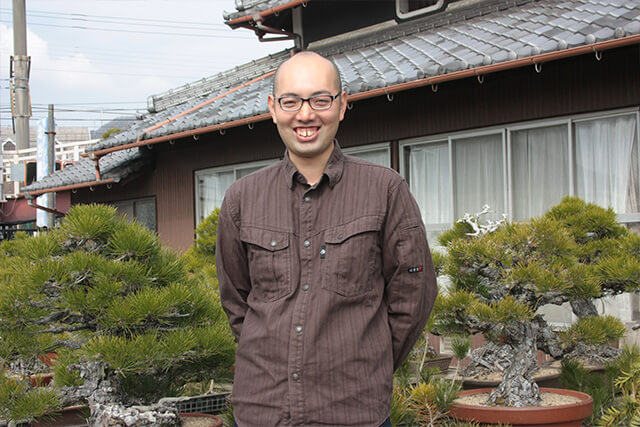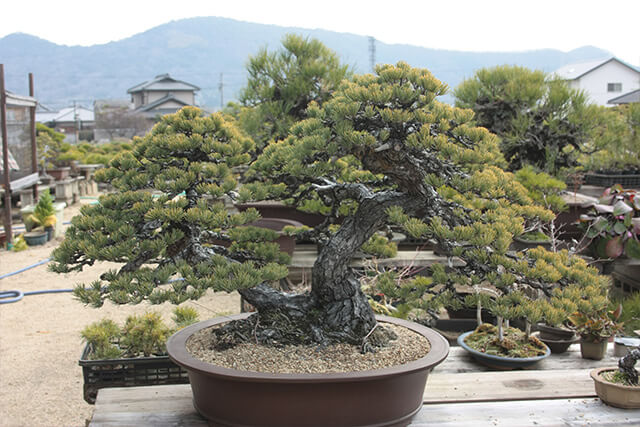Lined with Japanese black pine bonsai collected in the mountains of the Seto Inland Sea’s islands Kitadani Yoseien
Bonsai using naturally-shaped trees collected from mountains are valuable
Located in an area northeast of Kinashi Station, Kitadani Yoseien boasts 400 to 500 Japanese black pine bonsai estimated to be more than 100 years old. Kitadani Yoseien collected these black pines in the mountains of the Seto Inland Sea’s islands about 60 years ago.
Known as yamadori (collected in the mountains), these bonsai are valuable because they differ from many other bonsais grown on farms. They are trees grown naturally in fields and mountains that have taken root in transplanted pots. People living on islands in the Seto Inland Sea grew Japanese black pines for firewood used to heat baths in the era when these trees were collected. Exposed to strong sea winds, pines that grow on islands become twisted, creating unexpected shapes that are the product of nature.

“The second-generation keeper collected these pines from the islands,” explains KITADANI Ryuichi, the fourth generation of Kitadani Yoseien. “The third keeper improved their shapes by working on them every day. I cannot spoil these valuables in my lifetime. My mission is to properly develop the potential of these excellent bonsai.” KITADANI says he naturally developed his desire to succeed his father to become the fourth keeper of the bonsai garden by watching him hard at work.


Watering accounts for 80% of bonsai culturists’ work. Growers give water to respective bonsai trees every day while asking the bonsai questions, like if their leaves and trunks are full of vitality, or if the soil has dried up. They can prune and transplant the trees for the first time while their health as plants is maintained. There are 1,500 pines planted on the grounds and 2,000 pine seedlings at Kitadani Yoseien, in addition to 2,200 potted pines. KITADANI is taking care of all these plants with his father, the bonsai garden’s third keeper.


I just love pines so much. But loving them too much is no good.
Bonsai are living works of art. There is the possibility of their value as art increasing with care because bonsai change over the years. No other art has this unique appeal, and it draws KITADANI to bonsai.
“I just love pines so much,” says KITADANI, embarrassed. “My genes may be bent toward bonsai, but loving them too much is no good.” Enthusiastic devotees who admire bonsais feel reluctant to sell them, or price them too high. Becoming attached to the bonsai can be harmful. KITADANI says he tries to value a sense of detachment from the bonsai.
These words convey how much KITADANI loves bonsai. He interacts with his bonsai exactly the same way he looks after his children.


An heir, representing a new generation, pursuing development in harmony with the times.
To teach beginners how to grow bonsai, KITADANI has created a YouTube channel called Fourth Owner’s Private School for Keeping Bonsais Alive. He doesn’t limit himself to instructional videos on YouTube but is also on Facebook. Social media has been a particularly good way to connect with foreign enthusiasts, and the number of foreign visitors is increasing at Kitadani Yoseien, too. KITADANI is aware of the great potential of bonsai overseas, even though export regulations pose difficult problems.
“The culture of bonsai enthusiasts has always been to bring their bonsai to shows to compete in their artistic qualities. That has been the norm in Japan up to this point,” notes KITADANI. “We are entering a new era of active internet use. I’m thinking about doing something delightful which will allow enthusiasts to engage on the web.”
KITADANI is thinking about generating new value while protecting the life of bonsai and preserving professional skills and passing them to the next generation of bonsai enthusiasts. Amid the bonsai, he is leading a very happy life.

Kitadani Yoseien

- ADDRESS
- 36-1 Fujii, Kinashi-cho, Takamatsu City, Kagawa Prefecture
- TEL
- +81-87-881-2924
- URL
- https://www.youtube.com/channel/UCYQHnD7cuwC5RZ2PqiLpMuw

